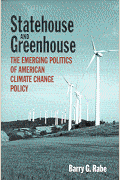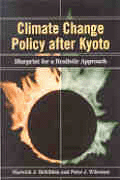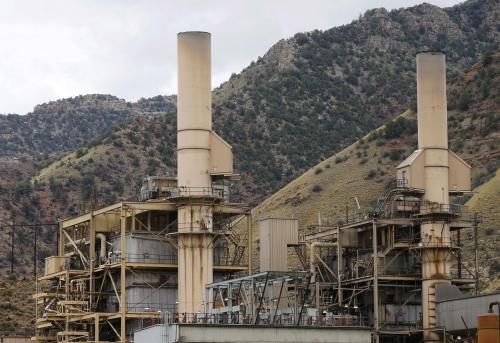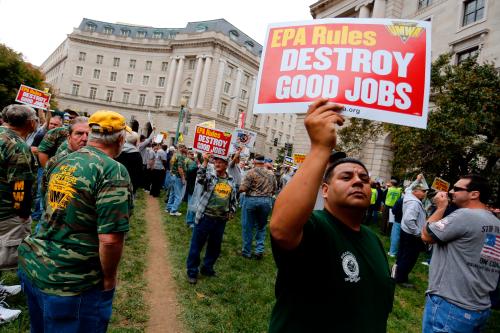The Clean Power Plan, which led a short but eventful life, was killed by an Executive Order signed by President Donald Trump at the Environmental Protection Agency (EPA) on Tuesday. A few of the Clean Power Plan’s most ardent admirers may insist that it still has life, and in some technical sense they are right—even the administration concedes that it will have to work painstakingly through the notice and comment rulemaking process to review and redo the rule, and that there will be litigation once they proceed. But everyone knows these are mere formalities, with the end result sure to be a rule that looks nothing at all like its predecessor (or perhaps no rule at all). And so the centerpiece of the Obama administration’s climate action plan is now well on its way to becoming a case study for policy historians rather than something industry or state government needs to worry about complying with.
There are some clear lessons in the Clean Power Plan’s demise. Most obvious is: live by the pen and phone, die by the pen and phone. Clean Power Plan defenders would like to argue that the rule was somehow a natural extension of the Clean Air Act, and that it once the Supreme Court decided Massachusetts v. EPA (2007) in environmentalists’ favor, something very much like the Clean Power Plan was clearly implied. That was always a stretch. Indeed, it is closer to the mark to say that the Obama administration sought to build out an effective policy platform for a moderately ambitious climate program on a very unsteady legal foundation, given their inability to get a more reliable one through Congress.
The Supreme Court never descended to the details of the Clean Air Act, which was always an awkward fit for trying to address climate change, and certainly nothing in the statute made it clear that the EPA was in a position to effectively force fossil fuel-fired power plants to subsidize wind and solar producers (as the Clean Power Plan sought to do). EPA’s defenders first argued that four “building blocks” (making coal plants more efficient, shifting generation from coal to gas, promoting demand-side energy efficiency, and shifting generation to solar and wind) were “an inevitable byproduct of the architecture of section 111(d)” of the Clean Air Act. I argued in 2014 that that was nonsense, and it turned out EPA agreed: for its final rule (which was vastly altered from its proposed rule), the Clean Power Plan was down to three building blocks (admitting that energy efficiency measures were beyond its legal powers). Even that remained clearly the product of debatable policy considerations, with lingering legal and political vulnerabilities.
Today the political vulnerability has been exploited: a rule that was pushed through against the united opposition of one of the major political parties has been undone upon that party gaining control of the White House. All this was predictable, and predicted.
That leads to another, only slightly less obvious, point: political sustainability needs to be a central concern of any regulatory program designed to operate over the span of decades. That the Clean Power Plan’s supporters talked themselves into mostly ignoring this point is especially remarkable given the fact that the rule was designed to exert active controls only beginning in 2022. That meant Democrats would need to retain control of the White House for a full four terms to shepherd it into effectiveness, never a good bet in American politics.
Disturbingly, there are those who would argue that political sustainability is simply impossible on most issues in American politics today, and that parties therefore need to take what they can get. According to this view, even if the Clean Power Plan is being wiped away now, it may be seen as having served honorably and usefully during its short life, by changing industry’s expectations about future regulatory requirements and by facilitating the international negotiations that eventually led to the Paris Agreement. Those who see climate change as a serious problem should thus honor the Clean Power Plan and even fight tooth-and-nail to stop it from being rescinded.
This mindset is completely oblivious to opportunity costs, and ties the cause of climate change to a sinking ship. As long as the Trump administration is determined to render the Clean Power Plan a nullity, it will certainly be able to do so, regardless of what rearguard court victories environmentalists might win. Devoting the energies of the climate change community to this fight necessarily mean they will be diverted from other, potentially more useful, battles. Fighting for the Clean Power Plan has exacerbated the polarization of climate change, making a politically sustainable policy stance less likely. And, in truth, the benefits secured by the shadow of the Clean Power Plant during its brief existence were quite meager.
That leads to a final lesson, which unfortunately people are reluctant to accept because it seems so demanding: policymaking without Congress in America’s constitutional system will not work, especially on matters of clear importance. If a program can’t get the support of Congress, chances are that it also lacks the kind of support it will need to survive inevitable political vicissitudes. Perhaps the false start with Republicans’ American Health Care Act leaves this lesson in doubt; but implementation details, now in the hands of Republicans, are paramount, and we should remember that the Republicans are likely to have more chances to decisively reject the central features of the Affordable Care Act. One party can impose its will against the concerted opposition of the other only with an extraordinary run of political support as we saw in the 1930s and 1940s.
More often, America’s constitutional democracy forces people who do not agree with each other to find mutually acceptable compromises. When they forget that, prioritizing particular policy goals, the result is likely to be huge amounts of human capital sunk into policies that will ultimately not endure. That is the tragic lesson of the Clean Power Plan, if we are willing to learn it.









Commentary
The Clean Power Plan, 2014 – 2017
March 30, 2017